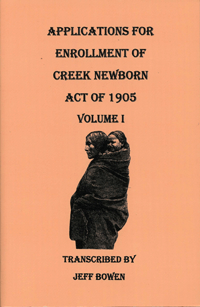
|
|
|
| Product Information: | ||
| Details: | Applications for Enrollment of Creek Newborn — Act of 1905. Volume I ; by Jeff Bowen; Published: 2011; Paperback; viii + 342 pp; 6x9; ISBN 9780806355344; Item CF9805 This series transcribes the Applications for Enrollment of Creek Newborn, National Archive film M-1301 (Act of 1905), as described in the National Archives publication American Indians. These applications represent one component of the larger body of applications for Enrollment of the Commission to the Five Civilized Tribes, 1898-1914 (Dawes Commission). Under the terms of the Dawes Allotment Act of February 8, 1887, which established the Commission and had the effect of breaking up the Five Civilized Tribes as social units, parcels of land within the Indian Territory were to be awarded to Native Americans according to their degree of Indian blood, age, and family status. The term "newborn" referred to each Creek individual living within a qualified Creek (or other tribal) household who was four years of age or less and not an orphan--up to the time that the President awarded the land allotments. Under this definition each Creek newborn was to receive forty acres of Indian Territory. The importance of the original Creek applications found in M-1301 and transcribed in this series is that they contain more information and establish family relationships not found on the census cards in National Archive film M-1186, the basis for the seminal title Final Rolls of Citizens and Freedmen of the Five Civilized Tribes in Indian Territory [and] Index to the Final Rolls. As Mr. Bowen explains in his Introduction, on July 25, 1898, the Interior Department established an Indian Territory Division to administer the Curtis Act of 1898, named for the Native American Senator Charles Curtis of Kansas. The Curtis Act mandated that new tribal population rolls be compiled for inhabitants of the Indian Territory. The leaders of the Creek Nation in Muskogee, who had hoped to retain their tribal organization, resisted this census requirement until 1904-05, when the Dawes Commission announced that its representatives would appear in seven towns of the Creek Nation and accept notarized official applications for its newborn. Once the deadline for these applications had passed, the rolls establishing Creek citizenship would be closed. The Commission accepted applications for 2,410 children by the deadline of midnight, May 2, 1905; however, only 1,171 of those claimants were ultimately approved. Mr. Bowen's transcriptions include all correspondence associated with the 1,171 successful Creek claimants. Besides the names of all parents and "newborns," the applications include the names of doctors, lawyers, midwives, and other Creek relatives whose identities were divulged as part of the application process, and who attended to the Creek Nation before and during this time in history. In all, researchers will find over 2,000 Creek connections in the name index to this inaugural volume. |
|

